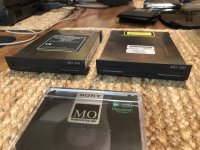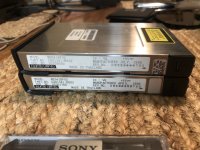trigf
Well-known member
I'd like to put together a thread to gather information on a couple of PowerBook 5300 accessories that may or may not exist, and may or may not have seen the light of day. Read on to gather what I've found.
Documented by former Apple engineers in the book, AppleDesign: The Work of the Apple Industrial Design Group, the PowerBook 5300 was not going to be the first Powerbook to ship with a CD-ROM drive. Instead of featuring a standard 5.25 inch CD-ROM drive, a marketing executive pushed to brand the M2 (the 5300's code name) as the "smallest" full-featured laptop available. This meant that there was no room in the chassis for a full sized CD-ROM drive. Instead, the engineering team began work on a 3.5 inch cartridge-based magneto-optical drive. As far as I can tell, this magneto optical drive has never seen the light of day.
This article (and the Wikipedia article using it as citation) is the only reference to the first-party magneto optical drive I've ever seen. VST/LaCie, Fujitsu and Logitech all had expansion bay magneto-optical drives on the market in the late 90's, but there is nothing but the digital whisper of an Apple-branded version. If I had to guess, I would say that Apple pulled the plug quietly, and left this need to be fulfilled by third party solutions.
This brings me to the next piece of impossible-to-find hardware for the PowerBook 5300 - the miniature CD-ROM drive only ever seen in prototype form, in the 1996 blockbuster film, Independence Day. As David (Jeff Goldblum) and his father are traveling to Washington DC, David is shown trying to stick a miniature 80mm CD-ROM into a CD-ROM tray, mounted in the expansion bay of his PowerBook XXXX. Never shown is David getting the CD-ROM onto the spindle, or shutting the disc tray. I note that in the brief moment that the tray is visible, it looks nothing like the CD-ROM drives that would ship in the upcoming 1400 and 3400.
All other close up scenes of the PowerBook XXXX clearly show a standard floppy drive in the expansion bay. Fun fact: You can also see a prototype "M-2" label where it would normally have the PowerBook 5300 label. David's Powerbook also appears to be running System 7.5.x, with Apple's Appearance Manager from Mac OS 8 installed, giving the OS the Platinum appearance that would appear with OS 8's release.
Barring an interview with Jeff Goldblum about a tiny, insignificant detail from a movie he did 23 years ago, I am apt to believe that this was simply a Hollywood prop. I'm confident that this 3.5 inch CD-ROM drive has never been seen outside of that movie, specifically that scene, in any form. I am creating this thread to document further developments in researching the prototype devices, and possibly one day hunting them down.
To be continued...
Documented by former Apple engineers in the book, AppleDesign: The Work of the Apple Industrial Design Group, the PowerBook 5300 was not going to be the first Powerbook to ship with a CD-ROM drive. Instead of featuring a standard 5.25 inch CD-ROM drive, a marketing executive pushed to brand the M2 (the 5300's code name) as the "smallest" full-featured laptop available. This meant that there was no room in the chassis for a full sized CD-ROM drive. Instead, the engineering team began work on a 3.5 inch cartridge-based magneto-optical drive. As far as I can tell, this magneto optical drive has never seen the light of day.
This article (and the Wikipedia article using it as citation) is the only reference to the first-party magneto optical drive I've ever seen. VST/LaCie, Fujitsu and Logitech all had expansion bay magneto-optical drives on the market in the late 90's, but there is nothing but the digital whisper of an Apple-branded version. If I had to guess, I would say that Apple pulled the plug quietly, and left this need to be fulfilled by third party solutions.
This brings me to the next piece of impossible-to-find hardware for the PowerBook 5300 - the miniature CD-ROM drive only ever seen in prototype form, in the 1996 blockbuster film, Independence Day. As David (Jeff Goldblum) and his father are traveling to Washington DC, David is shown trying to stick a miniature 80mm CD-ROM into a CD-ROM tray, mounted in the expansion bay of his PowerBook XXXX. Never shown is David getting the CD-ROM onto the spindle, or shutting the disc tray. I note that in the brief moment that the tray is visible, it looks nothing like the CD-ROM drives that would ship in the upcoming 1400 and 3400.
All other close up scenes of the PowerBook XXXX clearly show a standard floppy drive in the expansion bay. Fun fact: You can also see a prototype "M-2" label where it would normally have the PowerBook 5300 label. David's Powerbook also appears to be running System 7.5.x, with Apple's Appearance Manager from Mac OS 8 installed, giving the OS the Platinum appearance that would appear with OS 8's release.
Barring an interview with Jeff Goldblum about a tiny, insignificant detail from a movie he did 23 years ago, I am apt to believe that this was simply a Hollywood prop. I'm confident that this 3.5 inch CD-ROM drive has never been seen outside of that movie, specifically that scene, in any form. I am creating this thread to document further developments in researching the prototype devices, and possibly one day hunting them down.
To be continued...



